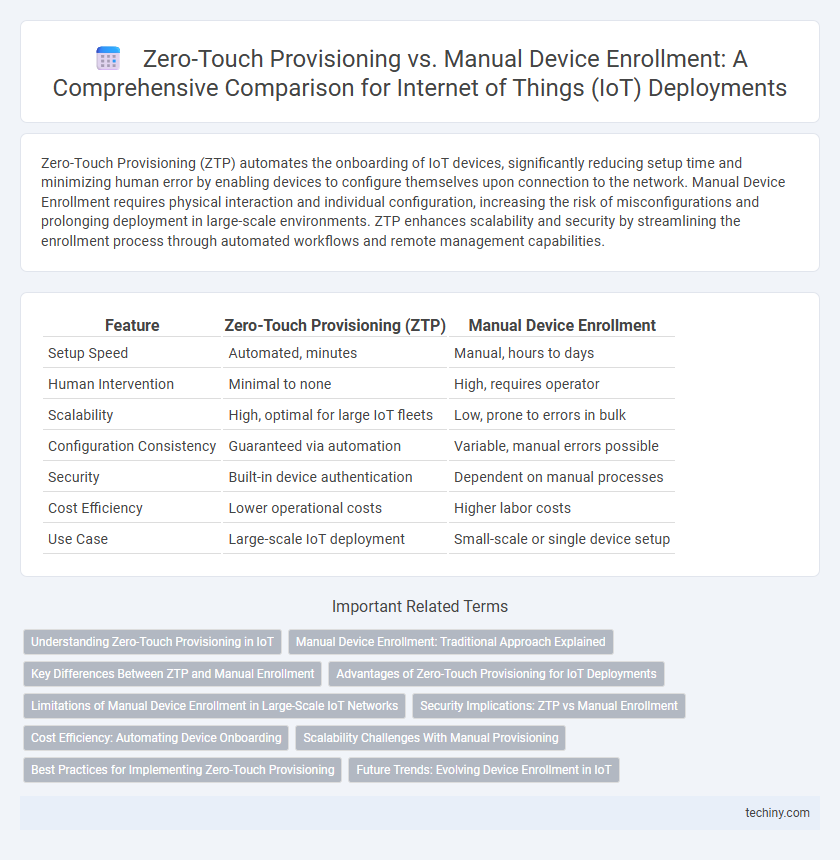Zero-Touch Provisioning (ZTP) automates the onboarding of IoT devices, significantly reducing setup time and minimizing human error by enabling devices to configure themselves upon connection to the network. Manual Device Enrollment requires physical interaction and individual configuration, increasing the risk of misconfigurations and prolonging deployment in large-scale environments. ZTP enhances scalability and security by streamlining the enrollment process through automated workflows and remote management capabilities.
Table of Comparison
| Feature | Zero-Touch Provisioning (ZTP) | Manual Device Enrollment |
|---|---|---|
| Setup Speed | Automated, minutes | Manual, hours to days |
| Human Intervention | Minimal to none | High, requires operator |
| Scalability | High, optimal for large IoT fleets | Low, prone to errors in bulk |
| Configuration Consistency | Guaranteed via automation | Variable, manual errors possible |
| Security | Built-in device authentication | Dependent on manual processes |
| Cost Efficiency | Lower operational costs | Higher labor costs |
| Use Case | Large-scale IoT deployment | Small-scale or single device setup |
Understanding Zero-Touch Provisioning in IoT
Zero-Touch Provisioning (ZTP) in IoT automates device onboarding by configuring and connecting devices to the network without human intervention, significantly reducing deployment time and errors. Unlike manual device enrollment, where each IoT device requires individual setup, ZTP leverages cloud-based management platforms to trigger configuration profiles immediately upon device activation. This approach enhances scalability and security in large IoT ecosystems by ensuring consistent device configurations and streamlining operational workflows.
Manual Device Enrollment: Traditional Approach Explained
Manual device enrollment in Internet of Things (IoT) involves physically configuring each device with specific network settings, security credentials, and management profiles before deployment. This traditional approach requires IT personnel to individually connect, authenticate, and register devices, leading to increased labor costs and potential for human error. Despite its simplicity, manual enrollment often results in slower rollout times and challenges in scaling large IoT deployments efficiently.
Key Differences Between ZTP and Manual Enrollment
Zero-Touch Provisioning (ZTP) automates the onboarding process of IoT devices by enabling configuration and network integration without human intervention, significantly reducing deployment time and errors. Manual device enrollment requires physical access and hands-on setup for each device, increasing labor costs and potential misconfigurations. ZTP leverages cloud-based management platforms and device identity certificates to streamline mass device enrollment, contrasting with the manual method's reliance on local interaction and individual device programming.
Advantages of Zero-Touch Provisioning for IoT Deployments
Zero-Touch Provisioning (ZTP) significantly accelerates IoT device deployment by automating configuration and reducing manual errors, ensuring scalable and consistent setups across diverse environments. This approach enhances security through encrypted device authentication and remote provisioning, minimizing physical interaction and the risk of human-induced vulnerabilities. IoT ecosystems benefit from ZTP's ability to streamline mass device onboarding, lower operational costs, and enable rapid scalability for complex network infrastructures.
Limitations of Manual Device Enrollment in Large-Scale IoT Networks
Manual device enrollment in large-scale IoT networks presents significant scalability challenges due to the time-consuming and error-prone nature of configuring each device individually. This approach often leads to increased operational costs, delayed deployment, and inconsistent security policies across thousands of connected devices. The lack of automation limits efficiency and hampers the ability to swiftly integrate new IoT endpoints, making zero-touch provisioning a more viable solution for expansive network environments.
Security Implications: ZTP vs Manual Enrollment
Zero-Touch Provisioning (ZTP) enhances security by automating device configuration, reducing human error and minimizing exposure to unauthorized access compared to Manual Device Enrollment. Manual enrollment requires physical interaction and credentials input, increasing the risk of data breaches, misconfiguration, and delayed security updates. ZTP leverages secure authentication protocols and encryption during initial device setup, significantly strengthening the defense against cyber threats in Internet of Things deployments.
Cost Efficiency: Automating Device Onboarding
Zero-Touch Provisioning significantly reduces labor costs by automating device onboarding, eliminating the need for manual configuration and minimizing human error. This automation accelerates deployment times and decreases operational expenses compared to traditional manual device enrollment processes. By leveraging cloud-based management and pre-configured device profiles, organizations achieve scalable and cost-efficient IoT network expansion.
Scalability Challenges With Manual Provisioning
Manual device enrollment in IoT networks faces significant scalability challenges due to the time-consuming and error-prone process of individually configuring each device. As the number of connected devices exponentially increases, this approach becomes inefficient, leading to delays and higher operational costs. Zero-touch provisioning automates device setup, enabling rapid, large-scale deployment without human intervention, thereby overcoming the limitations of manual provisioning in expansive IoT ecosystems.
Best Practices for Implementing Zero-Touch Provisioning
Zero-Touch Provisioning (ZTP) streamlines device onboarding in IoT deployments by automating configuration and reducing human errors, contrasting with Manual Device Enrollment's reliance on manual setup. Best practices for implementing ZTP include leveraging secure, cloud-based management platforms to ensure encrypted device authentication and continuous firmware updates. Incorporating scalable protocols like MQTT and standardized device identity frameworks enhances seamless integration and operational efficiency across complex IoT ecosystems.
Future Trends: Evolving Device Enrollment in IoT
Zero-Touch Provisioning (ZTP) in IoT is rapidly replacing Manual Device Enrollment due to its scalability and automation capabilities, facilitating seamless deployment of large device fleets. Future trends indicate integration of AI-driven analytics and blockchain for enhanced security and predictive management during provisioning. Evolving device enrollment will emphasize zero-touch processes to support dynamic IoT ecosystems with millions of interconnected devices requiring minimal human intervention.
Zero-Touch Provisioning vs Manual Device Enrollment Infographic

 techiny.com
techiny.com